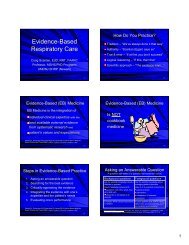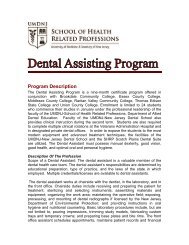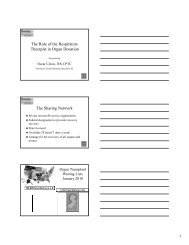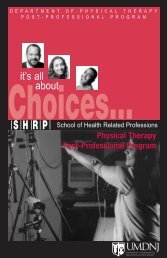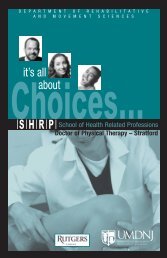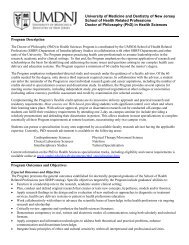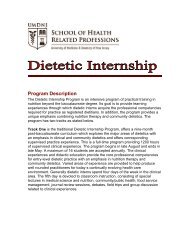Virtual reality-enhanced stroke rehabilitation ... - ResearchGate
Virtual reality-enhanced stroke rehabilitation ... - ResearchGate
Virtual reality-enhanced stroke rehabilitation ... - ResearchGate
You also want an ePaper? Increase the reach of your titles
YUMPU automatically turns print PDFs into web optimized ePapers that Google loves.
JACK et al.: VIRTUAL REALITY-ENHANCED STROKE REHABILITATION 311The finger velocity in the speed of motion exercise is takenas the mean of the angular velocities of the MCP and PIP joints.The performance measure isspeed MCP speed PIPFinger fractionation or independence of finger movement isFig. 4. PC <strong>rehabilitation</strong> session structure. (© Rutgers University. Reprintedby permission.)fractionation exercise involves the use of the index, middle, ring,and small fingers. The goal of the exercise is to flex one fingeras much as possible while the others are kept open. The exerciseis executed separately for each of the four fingers. The strengthexercise is designed to improve the patient’s grasping. The fingersinvolved are the thumb, index, middle, and ring. The patientis asked to close the fingers against the forces applied to his fingertips.To reduce fatigue and tendon strain, the fingers are movedtogether and the thumb is moved alone for all exercises exceptfractionation. The exercise is executed separately for the thumbbecause, when the whole hand is closed, either the thumb or thefour fingers does not achieve full range of motion. Executingthe exercise for the index, middle, ring, and small fingers at thesame time is fine because, here, the fingers do not affect eachothers’ range of motion.The <strong>rehabilitation</strong> process is divided into sessions, blocks,and trials. A trial consists of one execution of each exercise.For instance, closing the thumb or fingers is a range-of-motiontrial. A block is a group of trials of the same type of exercise. Asession is a group of blocks, each of a different exercise. Fig. 4shows the components of a PC <strong>rehabilitation</strong> session.C. Performance EvaluationDuring each trial, the exercise parameters are estimated onlinein order to drive the graphics display and provide feedbackto the patient. After the trial has been completed, data collectedon the patient’s movements are low-pass-filtered at 8 Hz to reducesensor noise. The parameters are reevaluated and stored,along with the filtered data, into the database.The patient’s performance is calculated per trial and perblock. The block performance is the mean and the standarddeviation of the performances of the trials involved.For the range-of-motion and strength exercises, the flexionangle of the finger is considered to be the mean of the MCP andPIP joint angles. The performance measure isMCP PIP MCP PIPPassiveFingerRangeActiveFingerRangewhere ActiveFingerRange is the current average joint range ofthe finger being moved and PassiveFingerRange is the currentaverage joint range of the other three fingers combined. Movingone finger alone results in a measure of 100%, which decays tozero as more fingers are coupled in the movement. The patientis prompted to move only one finger while trying to keep theothers stationary. This is repeated four times for each finger.D. Baseline Test and Performance TargetsImplementing target-based exercises requires an initial testto evaluate the patient’s baseline movement. The evaluation testhas the same structure as that of the PC <strong>rehabilitation</strong> sessionpresented in Fig. 4.A special case during the baseline test is the strength exercise,which uses the RMII glove. As mentioned above, the rangeof movement in this glove is somewhat limited, so another setof range evaluations is performed to obtain the patient’s meanrange while wearing the RMII. The patient’s finger strength isestablished by doing a binary search of force levels and comparingthe range of movement at each level with the mean obtainedfrom the previous range test. If the range is at least 80%of that previously measured, the test is passed, and the force isincreased to the next binary level. If the test is failed, then theforce is decreased to the next binary level, and so on. Test forcesare applied until the maximal force level attainable by the patientis found.The set of targets for the first session is drawn from a normaldistribution around the mean and standard deviations given bythe initial evaluation baseline test. A normal distribution ensuresthat the majority of the targets will be within the patient’s performancelimits. However, the patient will find some new targetseasy or difficult depending on whether they came from the lowor high end of the target distribution. Initially, the target meansare set one standard deviation above the patient’s actual measuredperformance to obtain a target distribution that overlapsthe high end of the patient’s performance levels. After a blockis completed, the distribution of the patient’s actual performanceis compared to the preset target mean and standard deviations.If the mean of the patient’s actual performance is greater thanthe target mean, then that target is raised by one standard deviation.Otherwise, the target for the next session is lowered bythe same amount. To prevent the block targets from varying toolittle or too much between sessions, lower and upper boundsare placed upon their increments. These parameters allow thetherapist to choose how aggressively each training exercise willproceed. A high upper bound means that the targets for the nextsession are considerably higher than the previous ones. As thetargets change over time, they provide valuable information to



